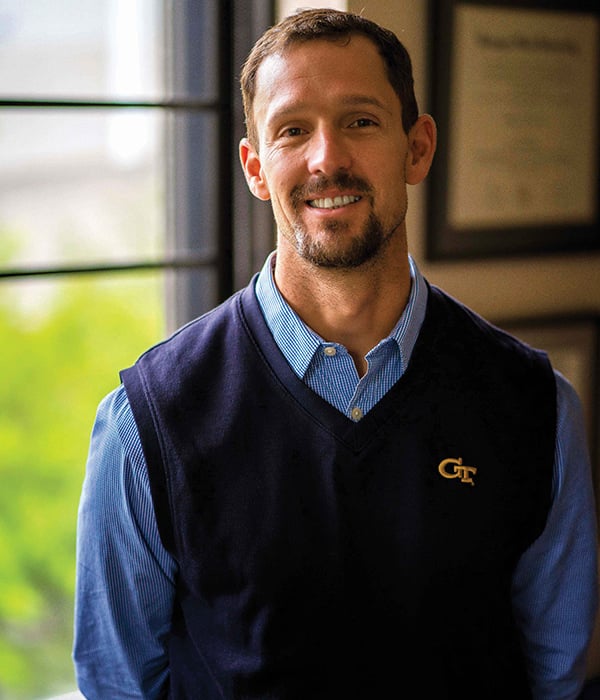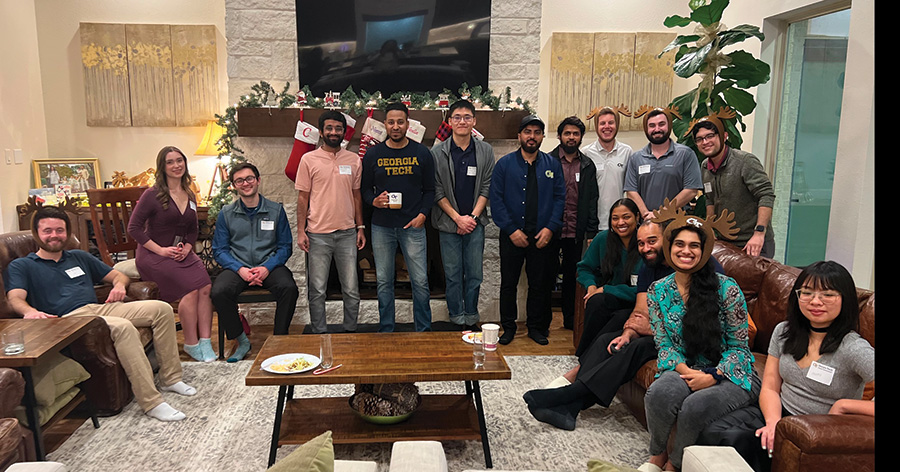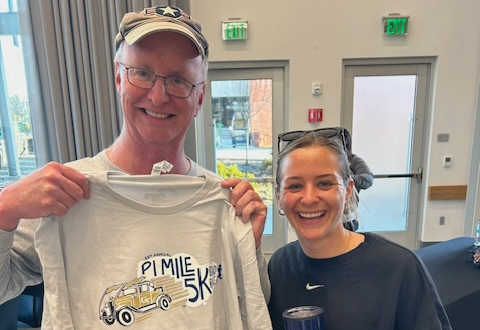Demystifying Admissions
By: Rick Clark | Categories: Alumni Interest
 There could not have been a more interesting or rewarding place to serve as the director of admission in the last decade than Georgia Tech. In that timeframe, first-year applications for admission have risen more than 42% in the last five years. In fact, this year, we had 45,348 applications for approximately 3,500 seats.
There could not have been a more interesting or rewarding place to serve as the director of admission in the last decade than Georgia Tech. In that timeframe, first-year applications for admission have risen more than 42% in the last five years. In fact, this year, we had 45,348 applications for approximately 3,500 seats.
As a result, we have changed everything about how we “do admission.” We have continually refined (or re-engineered) our selection process, reorganized our staff and adopted new technology platforms to better serve students and campus. In fact, last year our team received the Institute’s “Process Improvement Excellence Award” as recognition for these innovations.
The landscape of higher education has also shifted dramatically in the last decade. In 2008, we were in the middle of the “Great Recession,” and the press and public began severely questioning the value of a college degree in general—and specific majors in particular.
Since that time, many universities have closed their doors, abandoned lagging academic programs and grappled with how to remain relevant in the 21st century.
In contrast, Tech has thrived. We sit in an enviable and powerful position, because we are exactly who we were created to be in 1885: a place committed to improving the human condition and creating a better future through “Progress and Service.” During this time, it has been an honor (and a lot of fun) to preach “The Good Word” to potential students and usher in the next generation of Yellow Jackets.
I attribute much of our enrollment success to you, our alumni. You are unquestionably our best ambassadors. As influencers in your workplaces and communities, you proliferate the Georgia Tech brand by inspiring students and their families to consider us for their undergraduate degree. While nearly one-third of you graduated in the last decade, this is an ever-changing place, so I wanted to answer some of the common questions I hear from alumni.
WHY HAVE APPLICATIONS INCREASED SO MUCH IN RECENT YEARS?
Our popularity is a combination of factors. Again, coming out of the recession, families started putting a lot more emphasis on return on investment (ROI). Tech’s ROI consistently ranks among the best in the country according to publications such as Money, Kiplinger’s and Forbes. With an average starting salary of $70,000—more than $20,000 higher than the national average—Tech is on the radar of families nationally and internationally in unprecedented numbers.
Atlanta is also a huge part of our recent success. Students are increasingly drawn to all that cities offer such as restaurants, entertainment, a rich culture and a large, diverse population. As the city grows and improves, Tech benefits. New and exciting additions in our backyard like the Atlanta BeltLine, the AT&T Foundry and the up-and-coming Coda Building (as well as everything that springs up around those types of developments) make Midtown Atlanta more attractive than ever to prospective students. As an Atlanta native, I earnestly believe there has never been a more exciting time to be here than now.
Tech’s popularity is also linked to the rise of STEM at the K-12 level. As schools put more emphasis on and resources behind their science, math, technology and robotics curricula, it generates a bigger and more talented pipeline of students. This is certainly one reason that computer science is now our largest single major, and it also explains why places like the Scheller College of Business are so popular and rising in national rankings. Today’s students understand the necessity of understanding and integrating technology in all fields and sectors.
Lastly, you cannot discount the fact that we now accept both the Common Application and the Coalition Application today compared to providing a Tech-specific application that many alumni likely remember submitting. These applications—introduced in 2013 and 2017 respectively—streamline the admission process for students. While applicants still complete Georgia Tech-oriented, short-answer responses, they no longer have to fill out their name, address, birthday, etc. for each individual university. This does make it easier to apply, and students in 2018 applied on average to three more colleges than they did in 2008.
JUST HOW DOES TECH MEASURE ADMISSION SUCCESS?
Perhaps we should start by explaining that we do not define success by the number of applications we receive or the percentage of students we deny admission. If I miss anything about 2008, it is that we were accepting two out of every three applicants (although having Josh Nesbitt under center for the Yellow Jackets was also nice.) Thankfully, neither President G.P. “Bud” Peterson nor Provost Rafael L. Bras have ever played the “rankings game” in admission by asking us to chase applications in order to reduce our admit rate.
Instead, we assess success based on student performance. Tech’s first-year to second-year retention rate is 97 percent. (Compare that to the national average of 65 percent). Currently, there are only 25 universities in the United States with retention levels that high. “Look to your left, look to your right” is now a reference to the person that may ultimately help you co-found a start-up or become a fellow InVenture Prize team member. I attribute much of this success to former Tech President G. Wayne Clough, who set us on the right path by doubling down on the Institute’s commitment to student support.
Another key performance indicator is the average first-year GPA, which for students who began in the fall of 2017 set an Institute record-high of 3.45. Alumni often question if this is simply grade inflation. The short answer is no. This is Georgia Tech. We have always enrolled smart, capable students. The difference is that now there is a strategic and unified effort by academic advisors, residence hall staff, student affairs folks and faculty to help students immediately plug into the campus support system.
We also monitor our four-, five-, and six-year graduation rates. Currently, all are at record highs (47 percent, 85 percent and 87 percent, respectively). While we would like to see these continue to increase, our bigger focus in the undergraduate experience is on teaching students how to think and adapt; helping them gain valuable knowledge and skills; and providing them opportunities to expand their global network. While some colleges are intent upon ensuring students are gone in four years, our goal is to prepare them for 40 years of success.
WHO IS THE IDEAL TECH STUDENT?
I do not think the typical Tech student has changed that much since 2008—perhaps not even since 1888. We have always attracted smart, hard-working, innovative, entrepreneurial students who love to ask, “Why?”
Having personally taught GT1000, sponsored clubs on campus and employed hundreds of Tech students, I know this firsthand. They incessantly ask questions. But importantly, our students never stop with simply pointing out problems. They always follow the “Why?” with “How?”— as in “How can we improve this?” Or “How can we make this more efficient or cheaper or more accessible?”
The ideal Tech student still possesses a rare combination of intelligence, passion and humility that allows them to continually learn and collaborate. They like to be challenged and stretched—and to be around others who do so as well.
WHAT DOES TECH LOOK FOR IN APPLICATIONS?
Until 2009, we were essentially using a formulaic admission process to make decisions. Talking to students about admission was easy because everything was clear. “What is your GPA? What is your SAT?” At that time, essentially, if you had around a 1250 or higher SAT and a 3.7 or higher GPA, you were in. It was like running track. We set a hurdle and students jumped it or they did not. We ran the formulas, plugged decision codes into our system, and voila! Change the toner, print the letters, grab a coffee, lick some stamps and call it a freshman class.
As both the number and quality of applicants has risen sharply and our first-year class size has remained relatively stable, we have shifted to a holistic admission review process. Essentially, this means that we now look at far more than just academic factors. Last year, two-thirds of Tech applicants scored over 1400 on the SAT. Most are taking incredibly tough courses and rank in the top of their class. (Yes. It is a humbling job to spend months reading applications of students who are much brighter at 17 than I will ever be.)
The truth is that based on grades and scores alone, we could easily admit 75 to 80 percent of applicants.
Since Institute data shows that test scores are not the sole predictor of success on campus, and because so many students are closely grouped in the higher ranges academically, our admission committees move extremely quickly past these to consider other factors.
These committees, which also includes faculty review, now look at a student’s high school context, the classes they had access to, the level of rigor they selected, and how they did in those courses. Essentially, we are asking: “Does this student like to be challenged and respond well when they are?”
Outside the classroom, we ask applicants to complete an extra-curricular section on the application and to review their contributions within their community. We are asking what impact and influence they have had in their schools, on their teams or clubs, within their families, with nonprofits, at their jobs or in their research.
A common misconception is that we want each student to be “well-rounded.” The truth is that we do not expect them to have “done it all.” Instead, we are asking. “Will this student be missed when they leave?” “Have they left an indelibly positive mark?”
Ultimately, we want students who will challenge and stretch their peers on campus and beyond once they graduate. We are not concerned with whether they had a specific title, but rather if we see evidence that they are making people around them better. In order to find this, we also closely read their essay and short answer responses, as well as their recommendation letters from teachers and counselors.
Decisions are also a function of institutional priorities such as class size and demographic composition. Our target for the first-year class of 2019-20 is around 2,950. With over 20,000 applications submitted in our early-action round alone this fall, we expect our overall admit rate to drop under 20 percent for the first time in Tech’s history.
In addition, as a public university, we are committed to serving our state, so we intentionally select around 60 percent of our undergraduate students from the state of Georgia, 30 percent from out of state and 10 percent from outside the country. Last year, to achieve that desired geographic makeup, our admit rate for students from Georgia was 37 percent—significantly higher than our non-Georgia admit rate (19 percent).
DOES LEGACY MATTER IN THE ADMISSION PROCESS?
Roughly 6.5 percent of our nearly 36,000 first-year applicants last year had a legacy connection to Tech. We define legacy as having a parent, sibling or grandparent who attended Tech or who currently serve as a faculty or staff member. The legacy admit rate was 15 percentage points higher than our overall average. I understand that some readers may argue, “Well, that’s just DNA at work!” We do value the impact that legacy students have on their class and the overall Georgia Tech community. In the current first-year class, nearly one out of every five students has a legacy connection.
Because the majority of legacy applicants are not admitted as first-year students, we created the conditional pathway. This is an opportunity to start college elsewhere, earn a 3.3 GPA or higher in specified classes, and then enter Tech as a transfer student the following fall. Interest in this pathway continues to grow, and over the last three years we have enrolled nearly 400 students through the Conditional Pathway Program.
THE FUTURE OF ADMISSION AT TECH
Over the next 10 years, we will continue to expand Tech’s reputation, relevancy and reach by enrolling talented students from around our state, nation and world. My biggest concern when we look at accomplishing this is the cost of a Tech degree. Georgia residents currently pay just over $29,000 annually, including tuition and fees, as well as housing and meals. (For those qualifying, a portion of this can be covered by the HOPE or Zell Miller Scholarship.) Out-of-state students now pay over $50,000 annually with all costs included. On average, our undergraduates leave with approximately $30,000 in student loan debt.
Increasingly, we are losing incredibly talented admitted students who are unable to afford Georgia Tech (or unwilling to take on significant student loan debt) to other universities. Scholarships funded by Tech alumni, including donations for unrestricted funds through Roll Call and programs like the G. Wayne Clough Promise Scholarship, are certainly part of the solution. The Promise Program provides Georgia families with a household income of under $33,000 a pathway to a debt-free Tech degree.
However, as the quality of our applicants goes up, so too does the quality of the colleges we are competing against (see below right). While on average Tech meets less than 40 percent of a family’s demonstrated financial need, many of our competitors are not only ranked higher, but they are also providing more robust financial packages—many meeting 100 percent of demonstrated family need.
Statistics show that over the last decade, students from middle-income families are steadily disappearing from our student body. I am deeply concerned by that trend.
A good example of how changing the financial conversation can increase reputation and quality is the Atlanta Public Schools Scholars (APS) Program, which we started several years ago. This program offers guaranteed admission to valedictorians and salutatorians from the system and covers their costs if they fall short of retaining the HOPE or Zell Miller Scholarship. Before the program began, we were only receiving 50 applications from APS schools. Last year we received nearly 200 applications from the system and were able to enroll more APS valedictorians and salutatorians than any other university in the nation.
Last year, we rolled out the Georgia Tech Scholars Program, which grants guaranteed admission to valedictorians or salutatorians from all across our state. This program was effective in helping us attract students from more of Georgia’s 159 counties, and ultimately Tech enrolled more top students than any other school in our state. I’m hopeful that at some point in the future, we’ll be able to add a financial component to this program that mirrors the APS Scholars Program.


